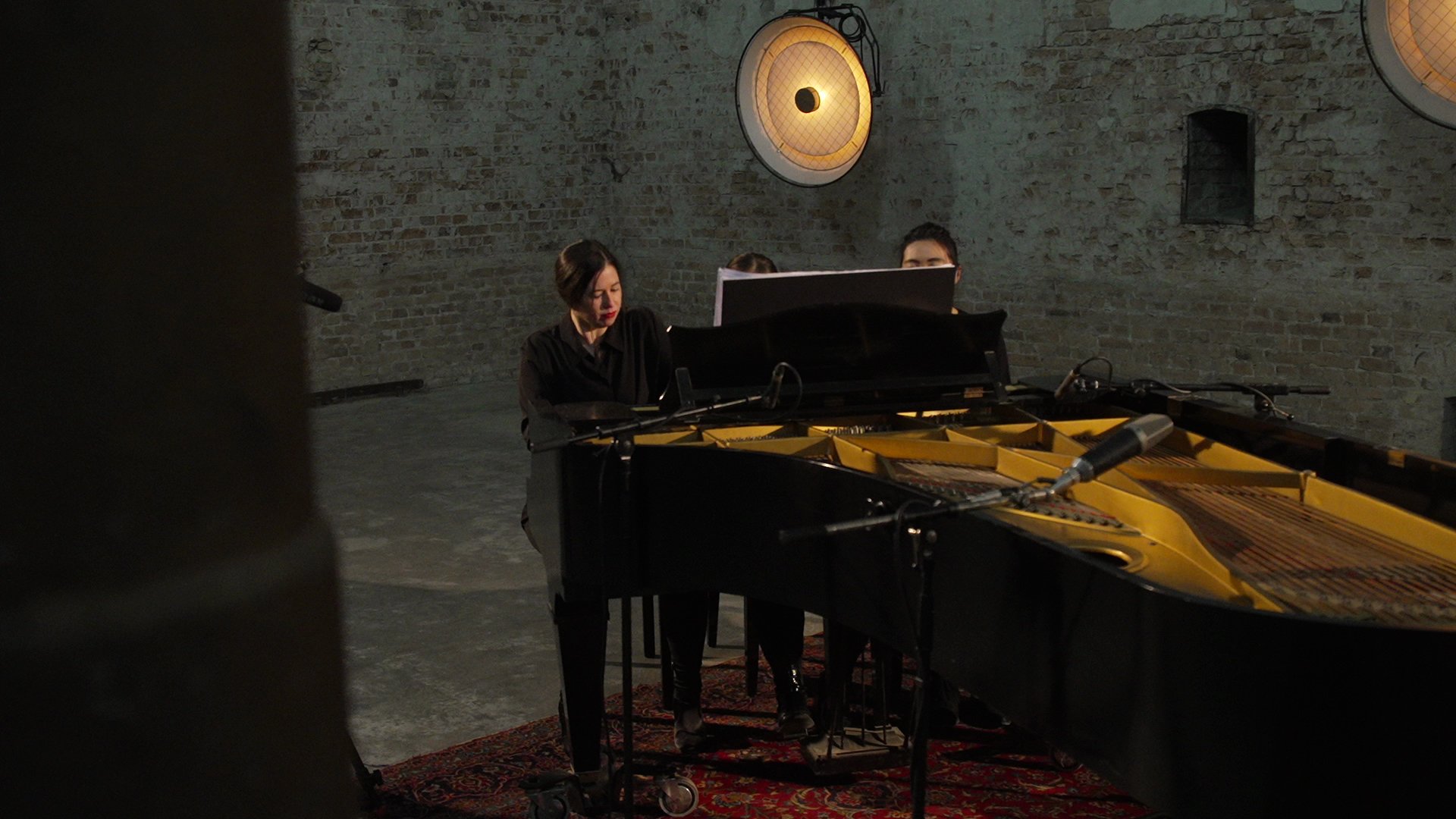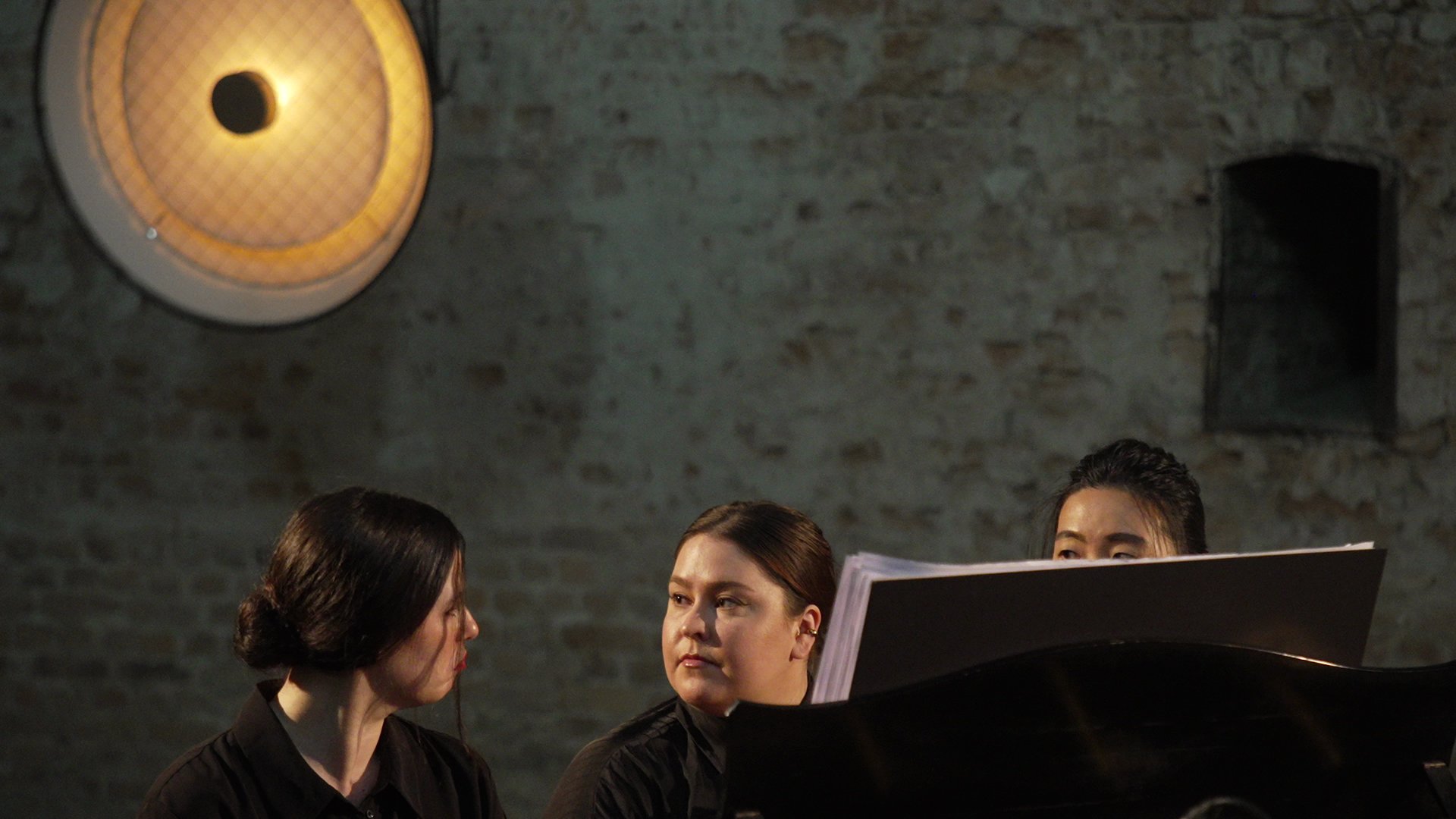m, her two severed hands, from [Orfeas-zyklus]
for piano six-hands
(2019-2022)
Filmed and recorded at Musikbrauerei in Berlin, November 15, 2022.
Commissioned by f:t with support from the Goethe Institut.
Performers: f:t (Magdalena Cerezo, Mabel Yu-Ting Huang, Jana Luksts)
Recording engineer: Remmy Canedo
Video: Berlin Videographers
Recorded and filmed at UFO Studios/Musikbrauerei Berlin
Directing: Robert Ackermann, Alexander Seidenstücker
Cinematographer: Benedict Sicheneder, Alexander Seidenstücker
Lighting: Iven Hausmann
Editing: George Katehis
m is a piece about mirrors. m is a triptych folded into itself.
m – her two severed hands is a work for three pianists on a single instrument (aka piano “six-hands”). It is dedicated to several pianists who have contributed immensely to my relationship to the instrument: Renate Rohlfing, Wesley Shen, and the commissioning ensemble f:t — pianists Jana Luksts, Magdalena Cereza Falçes, and Mabel Yu-Ting Huang.
m – her two severed hands was conceived in the fall of 2018 as an extension of two work-concepts/cycles which defined groups of pieces: “unity”, which began with a work for four performers (or a string quartet) performing on a single cello, and orfeas, a cycle of piano works for Jana Luksts inspired by Orfic texts. Work began in the fall of 2019 and a partially-completed version of the work was performed at a meta.ksi concert in March of 2020 in Toronto by Jana Luksts, Wesley Shen, and Adam Sherkin. The entire work as well as its accompanying intertextual motet was completed in October of 2022 with support by a virtual residency of the Goethe Institut, and it was recorded by f:t in Berlin that November. f:t premiered the work at Altefeuewach Köln in December of 2022.
m, due in part to its musical abundance, is a piece about a great many “things”. It is my first serious attempt at exploring polywork as a compositional mode: that is, in its simplest definition, a work which intentionally contains more than one “work” occurring simultaneously in a single piece. In more detail, I consider polywork to encompass a number of various strategies: the formation of elaborate webs of anterior pieces which are layered/mirrored/cycled, an abundance of diverse intertextual textual material, and an excess concentration of personnel on a singular instrument. In this last strategy, the competition/cohesion between the performers in attempting to interpret their own parts in “conventional” musical ways and their labor in doing so is thrust to the forefront of what we visually experience and itself becomes another “work” layered “on top” of everything and the thing that emerges most prominently at the surface of the listening/viewing experience.
In m, several works occur simultaneously, each composed almost totally separately:In m, several works occur simultaneously, each composed almost totally separately:
1) A totally new composition performed by performer #2
2) An older piano composition, the material of which is literally retrograded and “orchestrated”, performed by performer #1
3) A series of older short piano pieces in which the material is fragmented/”crunched”, performed by performer #3
4) The “total” work:
a) in which material is composed for performer 3 with consideration to the two upper parts as though they are a singular unit (as a kind of basso continuo), and
b) the entire aural compilation of works, as well as the visual theatricality of their performance, which is perceived by the listener/viewer
5) Finally, a totally separate composed intertextual spoken/sung motet, which may optionally be performed by the pianists, three vocalists, or a pre-recorded tape part, and layered on top of the work. This motet consists of several overlapped texts:
a) “Descent” (“Καθοδος”), a short poem by Yiannis Ritsos, from which the work derives its title:
Ευρυδικη, φωναξε. Κατεβηκε γρηγορα τη σκάλα.
Το θυρωρειο δεν ειχε φως. Εψαξε με τα χερια τον καθρεφτη.
Στο βαθος εφευγε η γυναίκα με την κίτρινη ομπρέλα.
Ή δεύτερη γυναίκα στο υπογειο του φωναξε <<είναι πεθαμένη>>.
Οι τρεις αεροποροι βγηκαν απ᾽ το ασανσερ με μια μεγαλη βαλιτσα
Κει μεσα ειταν τα δυο κομμενα χερια της και τα χειρόγραφα μου.“Euridice,” he called. He ran down the stairs.
There was no light in the entrance hall. He searched the mirror
with his hands.
At the far end the woman with the yellow umbrella was leaving.
The second woman in the basement called out to him: “She’s dead.”
The three airmen emerged from the elevator with a huge
suitcase--
inside it were her two severed hands and my manuscripts.
b) The Byzantine Funeral Evlogitaria (troparion) with Psalm refrain in the Plagal of First Mode:
“Εὐλογητὸς εἶ, Κύριε, δίδαξόν με τὰ δικαιώματά σου ... Αλληλούϊα, Αλληλούϊα, Αλληλούϊα. Δόξα σοι ο Θεός.”
c) The Lamentations of Jeremiah: O vos omnes qui transistis per viam (which constitutes a continued musical refrain in the piano piece, influenced heavily by Salamone Rossi’s obscure and beautiful setting) and Ierusalem, convertere (I refer to settings by Carpentras and the famous refrain from Tallis):
O vos ómnes qui transítis per víam, atténdite et vidéte:
Si est dólor símilis sícut dólor méus.
V. Atténdite, univérsi pópuli, et vidéte dolórem méum.
Si est dólor símilis sícut dólor méus.
d) Jose Cascante’s Villancico Nacimiento
e) The “pig” stele of Edessa
f) Fauvel, cogita from the Roman de Fauvel and the Omnis mundi creatura poem:
Fauvel, cogita,
Quod preterit
Mundi figura.
Fugit subita;
Sic interit
Quasi pictura.Fauvel, reflect that the shape of the world is passing suddenly; it perishes like a picture.
Omnis mundi creatura
quasi liber et pictura
nobis est in speculum:
nostrae vitae, nostrae mortis,
nostri status, nostrae sortis,
fidele signaculum.All the world’s creatures
As a book and a picture
Are to us as a mirror;
in it our life, our death,
our present condition and our passing
are faithfully signified.
Organizing the basic musical materials, as well as the larger polywork process, are a number of mirroring techniques:
1) Several layers of mirrors built into the pitch material of the performers, such as symmetricity of basic chordal and intervallic groupings,
2) Literal retrogrades are abundant: particularly one in a moment of great climax, and a “game” of arranging which allocates a previous composition to one performer but performed backwards
3) The visual mirroring in which the middle performer is enflanked with performers to the left and right.
4) The various metaphorical mirrors which pervade the work:
a) The musical material of the 3rd performer, which is largely composed the total fragmentation of older piano works of the composer into clustered passages or even singular chords: a self-reflection and emotional processing of the composer’s older works as Narcissus’ “pools of sorrow”
b) The various (unperformed) textual references which interpolate the score, primarily excerpts of Eco’s Name of the Rose
c) The performed textual material of the motet, namely Omnis mundi creatura and Fauvel, cogita
d) My continued relationship to academic and political reflections towards the region of Southeastern Europe, which concerns my main area of academic research. Particularly the metaphor of the mirror, which has a prominent position in discourses on the Balkans vis-à-vis (Western) Europe: “employed by authors involved in the discussion on modernity and modernization in the Balkans (Miškova 2006) ... foundations of discourses on other-ness and stereotyping. As Corinne Kratz (2002, 90) stresses, ‘other’ may be an opposition to which their neighbors define their own ideal selves, what Michael Kenny (1981) calls a ‘mirror in the forest’. The image of the Balkans as the European (half-) other easily resonates in these words: as Maria Todorova puts it, “that the Balkans have been described as the ‘other’ of Europe does not need special proof” (Todorova 1997:3).” (Petrovic, 13)















